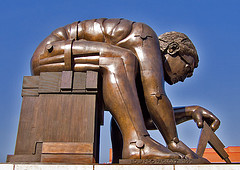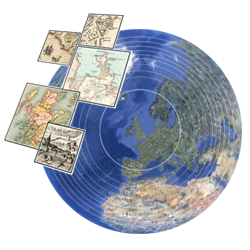
Access to the recordings is available free online, and requires Quicktime/WMP.
e-resources
Type – a visual history of typefaces and graphic styles
Recently added to the Library are two amazing books about typography, published by Taschen. These beautiful volumes are a collection of type specimens, initial letters, decorative lettering, engravings, borders and ornaments. Volume 1 covers 1628 – 1900 and Volume 2 explores 1901 – 1938.
When you borrow the book you also gain online access to over 2000 high resolution, downloadable images , which are great for building up your own archive of reference material. An ID and password are required and these will be given to you when you borrow the book.
New map georeferencing application
 The National Library of Scotland has just launched an exciting new application allowing their early maps of Scotland to be georeferenced and viewed in 3D as an overlay in Google Earth.
The National Library of Scotland has just launched an exciting new application allowing their early maps of Scotland to be georeferenced and viewed in 3D as an overlay in Google Earth.
Georeferencing is quick and fun and allows historic maps to be directly compared to present day satellite imagery.
It’s a collaborative online project where anyone with access to the internet can help to georeference various historical maps from the NLS collection.
More information can be found on the NLS website.
Visualising Urban Geographies
New dynamic maps of Edinburgh are now online through the National Library of Scotland’s collaborative Visualising Urban Geographies project with Edinburgh University. Included are 16 geo-referenced historical maps of Edinburgh from 1765-1940. They can all be compared together in Google Maps with present-day maps and satellite images. NLS have also created a 3-D representation of Edinburgh’s growth from 1450 to 1900 in Google Earth.
Online research resources: a reminder
eca library gives you access to a wide range of online research resources. These include various journals databases. Two popular databases are described here:
ARTbibliographies Modern:
ARTbibliographies Modern (ABM) provides full abstracts of journal articles, books, essays, exhibition catalogs, PhD dissertations, and exhibition reviews on all forms of modern and contemporary art, with more than 13,000 new entries being added each year. Full coverage begins in 1974 when the first volume was digitised, but entries date back to the late 1960s.
ABM is the premier source of information on modern and contemporary arts dating from the late 19th century onwards, including photography since its invention. It includes abstracts of English and foreign-language material on famous and lesser-known artists, movements, and trends. The coverage of ABM is wide-ranging and includes performance art and installation works, video art, computer and electronic art, body art, graffiti, artists’ books, theatre arts, conservation, crafts, ceramic and glass art, ethnic arts, graphic and museum design, fashion, and calligraphy, as well as traditional media including illustration, painting, printmaking, sculpture, and drawing.
ABM is used by students and researchers around the world to pinpoint publications and writings relevant to their area of study. Its extensive classification system and comprehensive abstracts make it an ideal source for information on artists, art movements, art history and theory, design, photography, and crafts.
Design and Applied Arts Index:
Design and Applied Arts Index (DAAI) is the leading source of abstracts and bibliographic records for articles, news items, and reviews published in design and applied arts periodicals from 1973 onwards. An indispensable tool for students, researchers, and practitioners worldwide, DAAI covers both new designers and the development of design and the applied arts since the mid-19th century, surveying disciplines including ceramics, glass, jewellery, wood, metalsmithing, graphic design, fashion and clothing, textiles, furniture, interior design, architecture, computer aided design, Web design, computer-generated graphics, animation, product design, industrial design, garden design, and landscape architecture. Around 1200 new records are added in each monthly update.
For more information about all our online resources take a look at the library pages on the student portal.
Free e-book on paper model design
Fundamentals of Paper Model Design is a free 2010 ebook by Angel David Guzman. Freely available in PDF format with additional Blender scripts, the 226-page book details how folded paper sculptures can be created using advanced 3D software such as the free open-source Blender suite. The book also gives an overview of other software used to create complex paper models. The book is clearly written and illustrated, and will be of use to a range of professions including contemporary fine artists, book artists, crafts makers, architects, stop-motion animators, stage set designers, and product designers. The book is deeply informed and is generally of a quality that would normally only come from a major publisher. There is a useful eight-page glossary.
Big change at Avery Index
College users of Avery Index, the important finding tool for architectural periodical articles, may have noticed that the library now sources this service through the database provider OCLC FirstSearch.
Use of the FirstSearch platform brings us into line with Edinburgh University and means that all architecture students, staff and researchers in the two institutions can access Avery through the same search interface.
FirstSearch searches the same Avery data as CSA Illumina, our previous supplier, and provides similar powerful search facilities and online help and search tips.
A seminar introducing College users to Avery Index via the OCLC FirstSearch interface will be arranged later this semester.
Avery Index can be accessed on or off-campus by following the links on this Portal page.